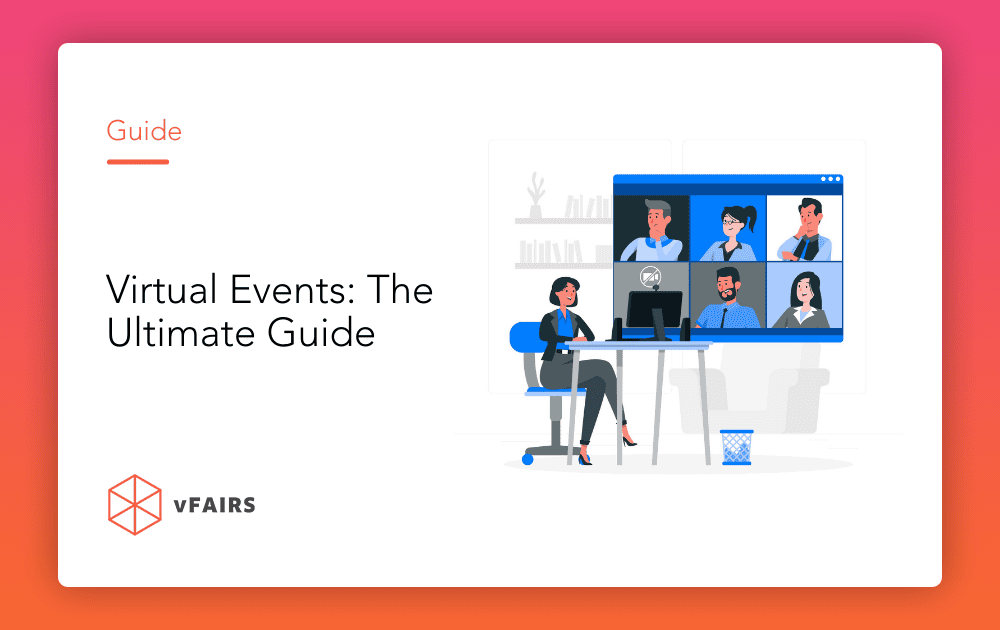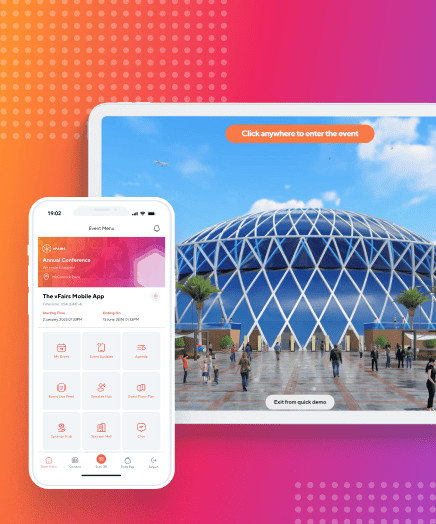Conferences, trade shows, career fairs, and seminars are widespread in the majority of businesses and large organizations. These events are part of larger campaigns to attract a broader audience, entice job seekers, or launch new products. As people return to in-person and hybrid events, where do virtual events fit in? Do they still have a future role in the events industry? Yes. Virtual events will be an important aspect of any organization’s overall event strategy in the future as they offer many advantages. They let you hire talent globally, connect professionals without hassles, and reach a wider audience, all while being inclusive, cost-effective, and convenient.
Chapter 1: What is a Virtual Event?
Virtual events are a digital alternative to in-person events where people can join from across the world. A virtual event takes place live over video on platforms such as Zoom, Microsoft Teams, or Facebook Live. Individuals can meet, exchange ideas, and do business with people from all over the world via a virtual event. These can be anything from small, private online meetings to big events with tens or even hundreds of thousands of people.
While many virtual events try to replicate the arrangement of an in-person conference or meeting, more and more virtual events are developing their distinct structure. You can now design personalized interactive webinar experiences and trade show booths to help people do business. You may also recruit applicants, and organize games, and interactive activities such as photo booths using virtual events platforms. Using integrations, you may have true face-to-face networking chances despite being virtual, making use of vFairs’ own Spatial Connect feature.
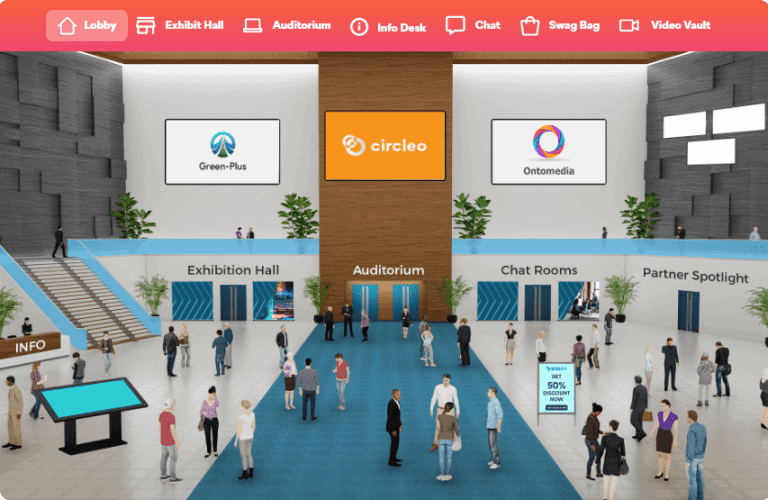
How Does a Virtual Event Work?
Running a successful virtual event requires specialized technology. While it’s possible to use your own tools, it would involve significant planning and management. Virtual events rely on various tools, but the benefits of using virtual event planning companies far outweigh the individual tool’s value. You can host virtual events using video conferencing tools like Zoom, Microsoft Teams, Google Hangouts, or even social media platforms. The key point is that organizers aren’t limited by location, offering numerous opportunities for audience connection.
Nowadays, online event platforms are common, offering unique features like interactive exhibit booths and networking options. They also enable integration with multiple platforms for a seamless virtual event experience. vFairs, for instance, is a top virtual event platform with customizable and user-friendly features to enhance attendee experiences.
Hybrid Events vs. Virtual Events
Hybrid and virtual events share a common goal: bringing people together. However, choosing between hybrid and virtual events can be a dilemma for many event planners. Virtual events allow attendees to join in exclusively through an online platform, while hybrid event platforms can combine the best of both worlds.
Some attendees may tune in virtually via a live stream while others attend in-person. Companies can also effectively incorporate their in-person events using virtual events platforms like vFairs to expand their overall reach. On a spectrum, hybrid events are located in the middle of in-person and virtual events.
Virtual Events vs. In-Person Events
Virtual events are the opposite of in-person events as they are exclusively online with no one-on-one physical human interactions. In-person events have a live and physically present audience, and a venue, and may demand more from event organizers in terms of cost and logistics. All event attendees including hosts and speakers need to be present at the venue at the time of the event.
Virtual Meetings vs. Virtual Events
Virtual meetings are real-time interactions and collaborations that happen online using an audio, video, or chat tool like Zoom, Skype, Google Meet, etc. Virtual events usually offer much more than virtual meetings to engage attendees. They can have an event lobby, keynote speakers, roundtables, networking rooms, a social media wall, or gamification such as a scavenger hunt, etc.
While most virtual events involve virtual meetings in one way or another, it isn’t necessary for all virtual meetings to be part of an event. Virtual meetings could be individual interactions such as a collaborative workplace meeting, a town hall, or an online class and are mostly internal. However, virtual events are usually designed for specific attendees and are curated for a target audience outside of your organization.
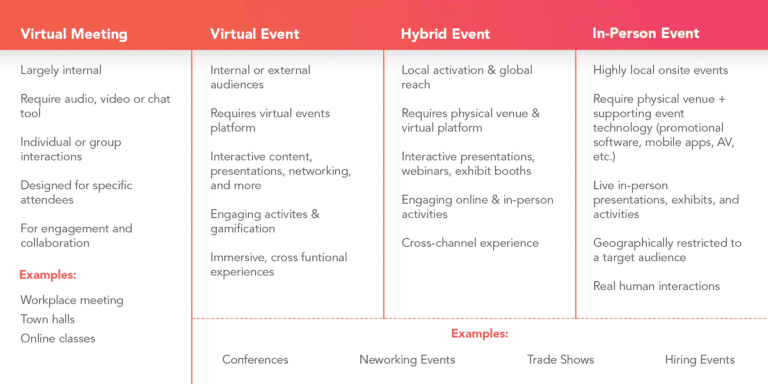
Why are Virtual Events Important?
Virtual events can be a great way to boost revenue and track key data about your audience. They also help planners broaden their audience and promote inclusivity. Virtual events can spread out content, networking opportunities, and event benefits across multiple days or interactions, providing attendees with more value. Moreover, hosts can maintain virtual events online even after they conclude, allowing participants to access content on-demand and ensuring a longer-lasting impact and engagement.
What is the Future of Virtual Events?
The future of virtual events promises to be dynamic and transformative, offering a blend of technological innovation, personalization, and sustainability. As digital experiences continue to gain prominence, virtual events will remain a valuable tool for connecting people, sharing knowledge, and achieving diverse goals across industries. Businesses all over the world can create deeply engaging and rewarding virtual events with careful planning and a well-structured, strategic approach.
Chapter 2: Types of Virtual Events
Virtual Conference
Virtual conferences unite professionals worldwide for topic-focused learning and discussion. They include sessions, breakouts, and keynotes, with the flexibility to have multiple sessions and community engagement tools. Attendees can watch keynotes live and personalize their schedules with on-demand content.
You also have the option to pre-record or live-stream the content. Many companies opt for pre-recording keynotes to ensure a smooth event day, while still offering live Q&A sessions with presenters, which has proven highly effective.
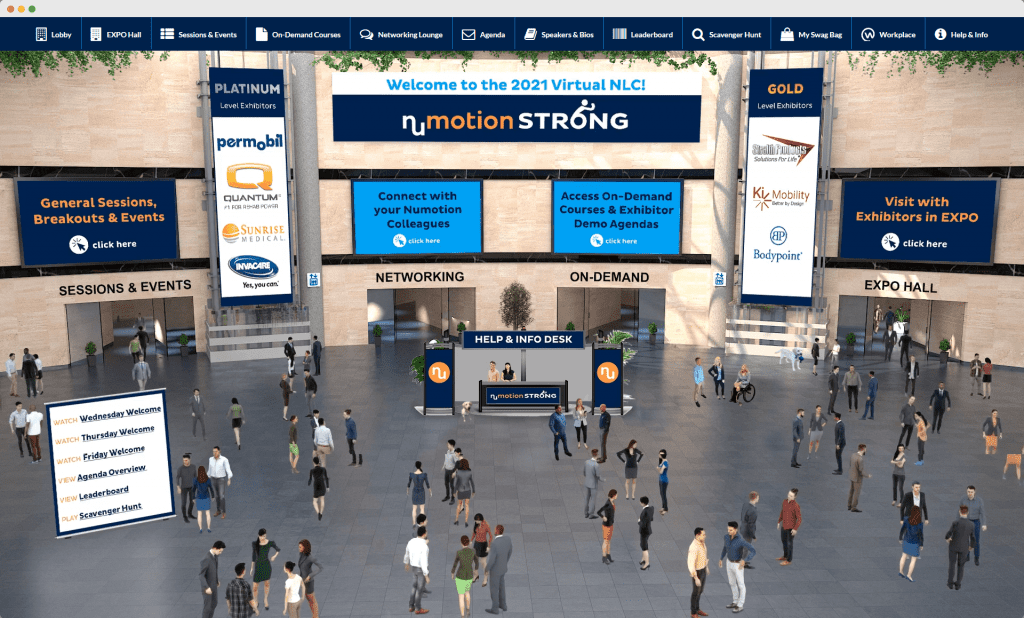
Virtual Trade Show
Any marketing expert will tell you that trade shows are great for driving sales, generating leads and strengthening branding while reaching out to a larger audience. Trade shows are typically a very exclusive event. Many industry brands and companies gather to talk about their newest products or simply connect with their audience.
The same principles apply to virtual trade shows. You can invite businesses and industry experts, set exhibition booths, host keynote sessions, display products and services, and interact with your audience through a virtual platform. The benefit is that your attendees can extend from more local audiences to buyers or leads from around the world!

Virtual Career Fair
Virtual career fairs allow candidates to meet recruiters and other employees to hire for open positions within your company. You’ll learn more about the hiring process and make connections with companies that are interested in hiring you. When you attend a virtual career fair instead of an in-person event, you won’t have to wait in line to speak with recruiters. You sign up for specific session times when you register for a virtual career fair, securing your place to engage with the employers you’re interested in.

Virtual Job Fair
A virtual job fair is an online event that helps multiple hiring employers hire candidates from anywhere in the world. Recruiters and job seekers meet in a virtual environment to exchange information about job postings through virtual networking, interactive exhibit booths and information sessions. These events are used most frequently by schools that are looking to place students in careers and associations that are looking to support their members. Many recruiting event technology companies provide virtual webinar and chat hosting platforms such as vFairs, which you can use for an event-specific hosted job fair.
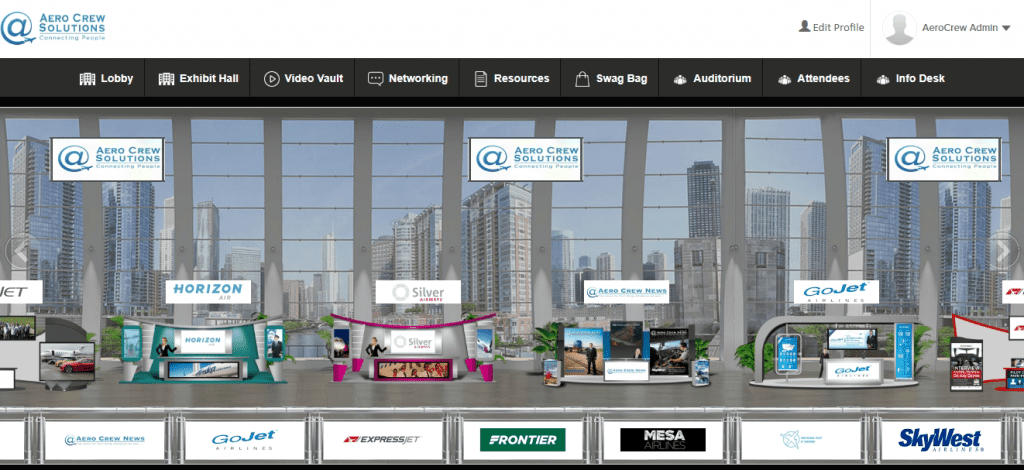
Virtual Training
Employer-facilitated training is now more than common in virtual environments, as organizations conduct business virtually and employees work remotely. Virtual training essentially replicates the fundamentals of face-to-face training on a virtual platform. It is a highly engaging, instructor-led training class with clearly defined training objectives and participants who meet in a web-based classroom environment.
Virtual Graduation
A virtual graduation ceremony is one in which students and their families around the world can enter into a user-friendly 3D environment that is modeled after their school. Custom landing and registration pages can excite students and their families. You can also enhance authenticity with features like animated graduate avatars, which are available on platforms like vFairs.
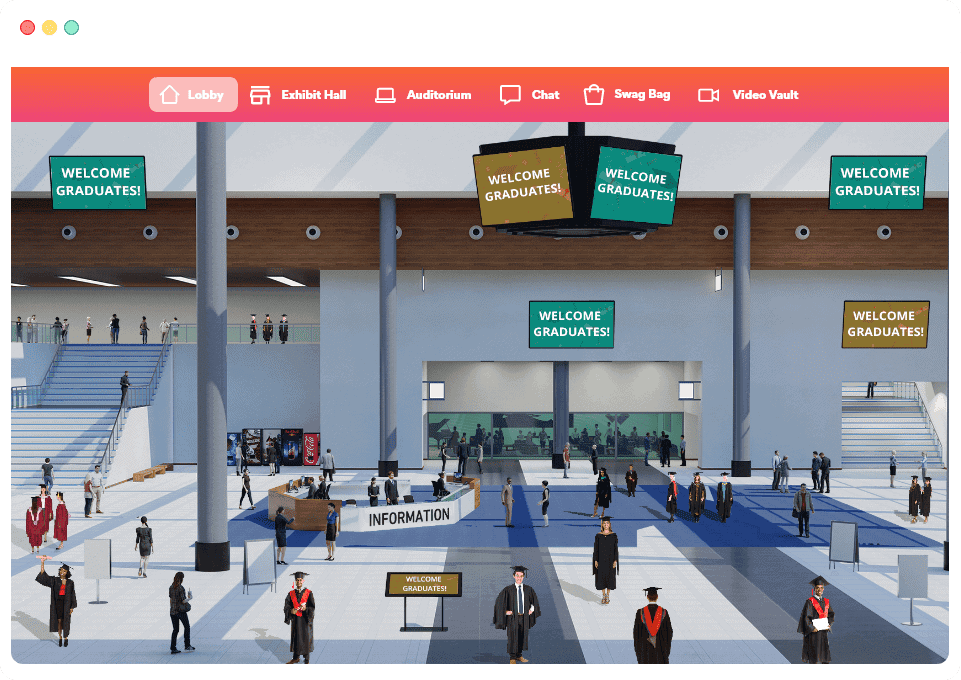
Virtual Exhibition
A virtual exhibition is an online event that is organized on a web-based comprehensive virtual exhibition platform. It enables exhibitors to display their offerings, meet prospects, and build their market presence. People across the globe can attend virtual exhibitions, so you can maximize visibility for your exhibitors by taking them to a global stage.
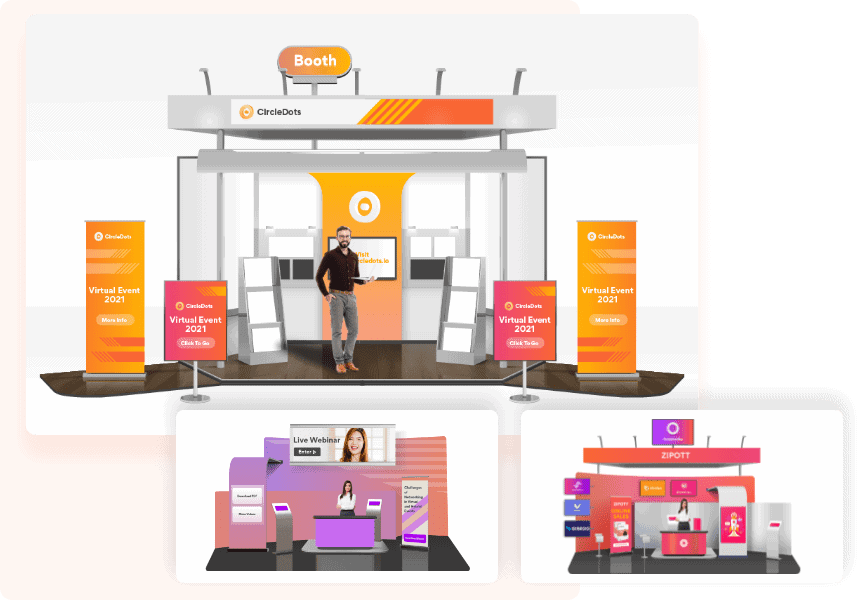
Virtual Events Powered by vFairs
There are various types of virtual events. Let’s have a look at a few of the best events hosted on the vFairs platform:
1. ICTC’s Virtual Career Fair
ICTC, a Canadian national expertise center, aimed to connect internationally educated professionals (IEPs) with employers in Canada’s ICT sector. To achieve this, they partnered with vFairs for a virtual career fair. vFairs offered full support to ICTC from planning to execution, ensuring a successful event.
vFairs enabled webinars for ICTC to provide informative sessions on various topics. Exhibitors, including employers and SMEs, had personalized virtual booths to showcase their organizations, job openings, and engage with attendees in real-time. The successful career fair had 180+ attendees with 1100+ booth engagements and 50+ webinar engagements. This event facilitated networking, job exploration, and knowledge-sharing, promoting the growth of Canada’s ICT industry and employment opportunities for professionals in the field.
2. Harbor Wholesale’s Virtual Trade Show
Harbor Wholesale‘s virtual trade show with vFairs resulted in a 35% increase in sales as compared to their previous trade shows. One of the key factors behind this outstanding success was the realization by Harbor Wholesale’s team that vFairs offered all the essential elements of an in-person trade show but in a virtual format. Attendees were able to immerse themselves in an environment that closely resembled a physical event, enhancing their overall experience.
These features included an animated lobby with avatars, an exciting exhibit hall with customizable booths, a realistic auditorium with speaker sessions, and much more. The success of the event demonstrated that Harbor Wholesale’s investment in virtual trade shows with vFairs was not only a sound strategic decision but also a testament to the power of innovative technology in reshaping the way businesses connect with their audiences and drive results.
3. University Of Dundee’s Virtual Open Day
The University of Dundee featured a total of 67 presentations highlighting their programs and colleges during the open day. Of these, 60 happened in real-time on the event day. These live presentations were accessible through links, and attendees could also later view recorded versions using the vFairs platform. Additionally, each faculty had a virtual exhibit booth to showcase their programs, courses, and the student experience during the University of Dundee’s virtual open day. This allowed students to explore different programs and gather information in various ways.
The post-event analysis was another valuable aspect of the virtual event. The team could swiftly and effortlessly track webinar attendance and participation, providing valuable insights.
Chapter 3: Virtual Event Benefits
Virtual events have numerous advantages, the most important of which is that they eliminate the logistics and limitations associated with in-person events. People from all over the world can attend, engage, and build relationships. Customers are always on the lookout for opportunities to network and have fun with their peers. You can provide all of those experiences while lowering costs, downtime, and lost productivity with a virtual events strategy. You can broaden your target audience, make your events accessible to more people, and shape the future of virtual events by doing so. Below are some key benefits of virtual events:
1. Increased Attendance Count
When compared to in-person events, virtual events have the potential for a higher attendance rate. More people are likely to participate because they can join from anywhere, and you can reach new audiences from around the world. There is no need to travel, and on-demand materials are readily available.
2. Significantly Reduced Expenses
Companies all over the world are saving a lot of money thanks to virtual event strategies. Statistics indicate that the cost is cut by at least 75%. Staff, venue, setup, hotels, meals, and travel expenses are just a few of the areas where a business can save money. In reality, the cost of the virtual meeting platform is the only factor to consider.
3. Eco-friendly Events
In most in-person events, attendees and exhibitors need to travel to a single location, which contributes significantly to the event’s carbon footprint, especially when people come from all over. However, virtual events drastically cut down on long-distance travel, often involving only a small virtual event production team.
Virtual events emit less than 1% of the carbon dioxide generated by live events. This reduction in carbon emissions is due to less travel, reduced waste, catering, land usage, and water consumption. vFairs has launched the Green and Global initiative to assist organizations in hosting environmentally friendly events and mitigating the harmful impacts of climate change.

4. Delighted Sponsors
In virtual events, your partners have more chances to engage with attendees and promote their brand. Exhibitors and sponsors can connect with attendees online, showcase their services through virtual communities, and eliminate the concern of empty physical booths. This leads to fewer trips and more meaningful, efficient interactions.
5. Effective Networking
The event host and attendees can now easily network and mingle from the comfort of their homes with a virtual event. Within a short period, anyone can connect with others from around the world. As compared to in-person events, networking is limited to geographical boundaries, whereas virtual events enable you to interact with individuals globally.
Virtual town hall meetings can help you make new connections, which can lead to more business opportunities and leads. It can also assist you in staying ahead of the competition and keeping up with industry trends.

6. Measurable Results
Businesses find it much easier to measure results now that almost everything takes place online. During virtual event hosting, you can collect information on your attendees such as when they logged on, from where they logged on, what they watched, the number of people who attended, their payment method, and more.
7. Saves a Lot of Time
Virtual events take some time to prepare before going live, but they aren’t as time-consuming as physical events. Even if you’re hosting an event online, you’ll still need to schedule time for marketing, registration, and promotion. Employees who normally attend live virtual events can shift their time and focus on driving sales instead while the live event is ongoing, as it can help your organization save time.
Chapter 3: Elements of Virtual Event Solution
While it’s possible to organize a virtual event without a dedicated platform, it can be challenging. Event platforms, like vFairs, provide valuable features for creating interactive and engaging virtual events. Continue reading to discover what vFairs and similar platforms can offer and how they can benefit you.
What is a Virtual Event Solution?
A virtual event solution allows users to easily host virtual conferences, meetings, seminars, online trade displays, virtual sports activities, and more. They have features that go beyond those seen in typical video conferencing software. These platforms facilitate digital experiences through built-in webcasting capabilities, collaboration with webinar software, or both.
Emoji reactions, gamification Q&A sessions, polls, surveys, chat rooms, exhibit booths, and other interactive components are available on virtual events platforms. vFairs is a leading virtual event solution that incorporates interactive content like Q&A, live polls, group chat, and 1:1 networking to help recreate in-person event experiences. It also offers a mobile event app to enhance virtual experiences, allowing attendees to access event information from any device.
Key Features of Virtual Event Solution
Most event platforms offer a wide range of networking, engagement, and lead generation tools depending upon the type of your virtual event. The tools can add a lot of value to the event for attendees, exhibitors, and event organizers. Here are some of the key features of virtual platforms that you are most likely to see:
1. Virtual Environment
When organizing your event, it’s crucial to ensure that the virtual environment is captivating enough to attract a large audience. Achieving this involves providing an interactive environment that incorporates the right designs to captivate your audience’s attention.
Moreover, a virtual environment simplifies the process for attendees to participate and extract maximum value from the event. This, in turn, enhances engagement and boosts registration numbers. The features within the virtual environment are designed to be user-friendly, making it accessible even to those who may not be tech-savvy. These features encompass:
- 3D animated graphics
- Customized venue settings
- Immersive virtual rooms
- Branded virtual booths
- Animated avatars
- A live help and information desk
2. Virtual Exhibit Booths
A virtual booth aims to engage attendees in meaningful conversation. You can choose from a variety of interactive booth designs, color schemes, unique graphics, and web page linkages. The virtual booth design might be 3D or page-based.
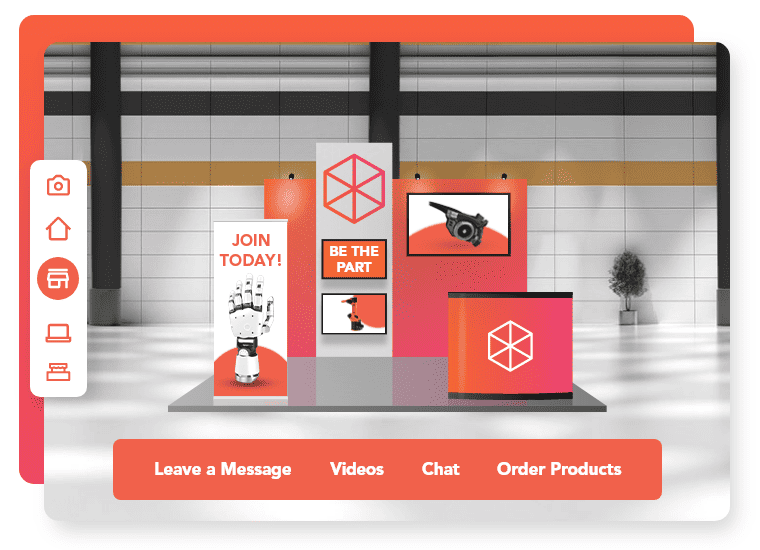
3. Webinars
Virtual events provide webinars, which are educational, interactive online seminars. They typically feature a host and one or more speakers discussing a specific topic. A virtual webinar uses tools like PowerPoint presentations, whiteboards, and polls to engage and instruct the audience.
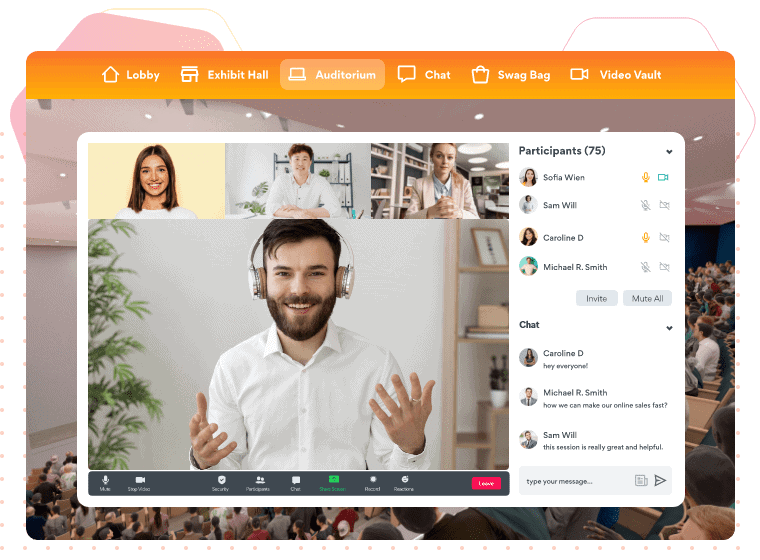
4. Live Broadcast
Live broadcasts are essential when it comes to virtual events. Sure, you can pre-record everything and then publish it on a virtual event website or YouTube channel. However, that approach does not form the same sort of personal connections that a live event does. Broadcasting sessions are a crucial component of hosting a virtual event.
5. On-Demand Content
One of the standout features of virtual events is their on-demand content. While physical events also offer this to some extent, capturing every moment can be quite challenging. This is where virtual events shine. Keynotes, presentations, demos, product showcases, and more can be conveniently accessed both during and after the event.
6. Accessibility Features
Just as with in-person events, it’s essential to prioritize inclusivity and accessibility in your virtual events. Participation in virtual events can be challenging for individuals with visual impairments or hearing difficulties.
Furthermore, when expanding your events internationally, you may encounter attendees who do not have English as their native language. To cater to all participants, it’s crucial to integrate a wide range of accessibility features. These encompass elements such as color contrast, screen readers, adjustable text size, video translations, real-time webinar translations, and live captions.
7. Gamification
Event gamification enhances event participation by using game principles such as goals, points, badges and certificates as participants accomplish challenges. Popular gamification features include leaderboards, virtual scavenger hunts and live trivia.
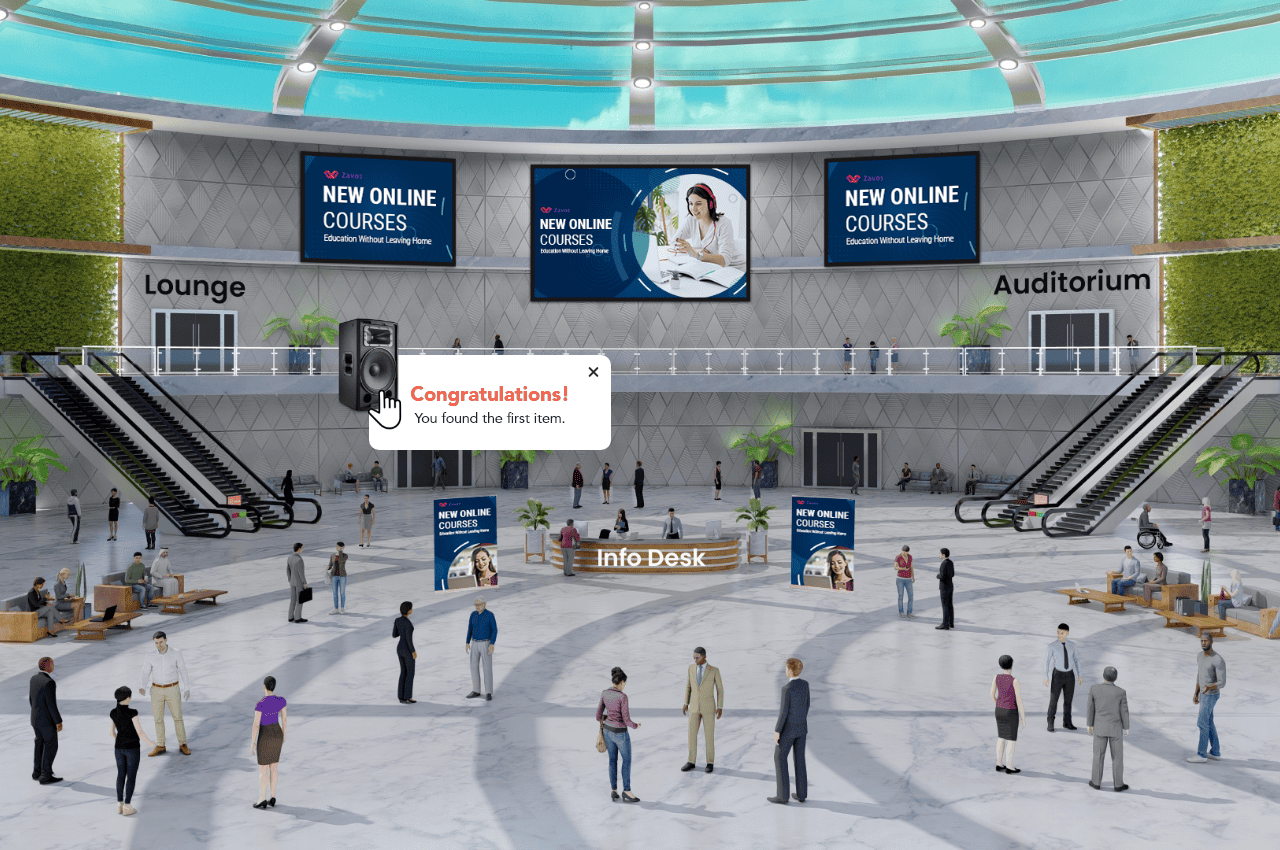
8. One-on-One Chat
Connecting with people from around the world is now effortless with one-on-one conversations. Attendees can easily locate individuals who share their backgrounds or interests and engage in conversations with them.
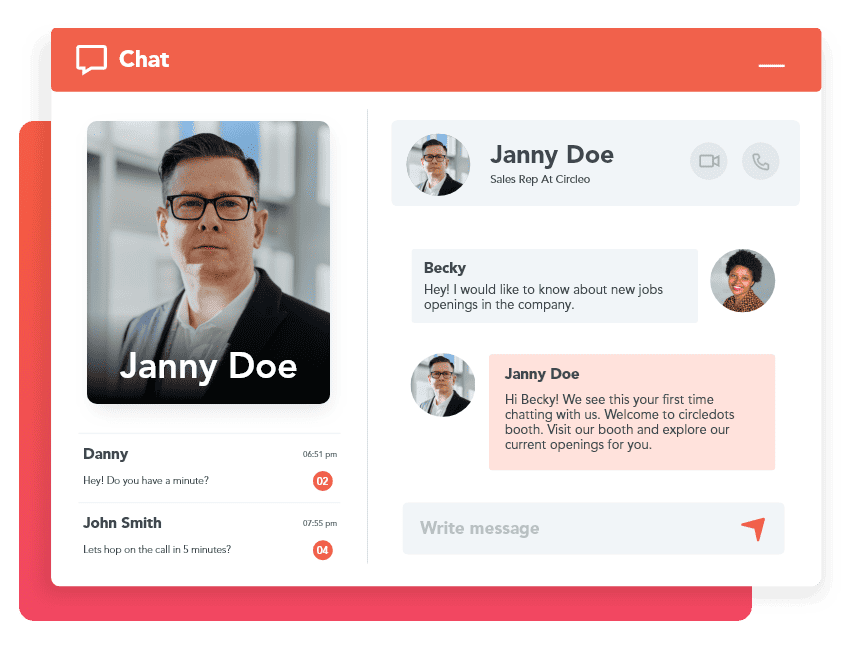
9. Networking
Networking features on a virtual event solution must be simple to navigate and use. Many platforms that use AI-based matchmaking algorithms will help your audience connect with people who share similar interests. vFairs offers this as their Smart Matchmaking feature and other impressive and immersive networking experiences such as Spatial Connect.
10. Customization
An effective virtual event management platform offers customization options to match your preferences. In today’s world, a brand’s image and presentation are as important as its products, if not more so. That’s why having a white-label solution is valuable. A great virtual event management platform lets you showcase your branding, enabling custom branding across the landing page, event lobby, auditorium, exhibition booths, and more.
11. Event Marketing Tools
The growing event technology industry has introduced various event marketing tools that event organizers can leverage for their benefit. Among these tools, creating an effective landing page is crucial for building anticipation and driving action, such as ticket sales and registrations. As an event marketer, your responsibility is to evoke a sense of excitement in potential attendees and then turn it into action. A well-crafted event landing page with the right message and a clear CTA can significantly boost registration numbers. With vFairs, you can produce marketing campaigns in minutes with AI assistant powered by ChatGPT.
Email Marketing
You may improve event registrations by simply following simple email marketing best practices for event promotion. It is important to get as many individuals signed up as possible as the event date approaches. That necessitates sending out reminder emails with a sense of urgency and a prominent CTA that encourages them to register.
Social Media Integrations
Event attendees expect updates via social media and rely on companies to communicate crucial information through their platforms. Potential guests can also communicate in real-time via social media, allowing them to ask questions, provide feedback, and engage in conversation.
12. Integrations
Platforms like vFairs enable plenty of integrations that give both the host and the participant access to various services. Some of the prominent integration partners include:
- ChatGPT
- HubSpot
- Salesforce Event Integrations
- Interprefy
- KUDO
- Marketo
- PayPal
- Stripe
- Restream
- Slido
- SyncWords
- Wordly
- Vimeo
- Walls.io
- Zapier
- Zoom
vFairs has a wide range of integrations that give both hosts and attendees access to various features. We’ve worked with the greatest service providers in the market, whether it’s for accessibility features or data analytics.
13. Analytics
Virtual events provide detailed information that extends beyond guest attendance. Virtual events data covers event participation, networking, and engagement with its thorough, observant graphs. The data analytics are largely accessible through the virtual events platform’s dashboard and you can simply export them. These analytics enable real-time monitoring of guests’ activity and help organizers with post-event reporting.
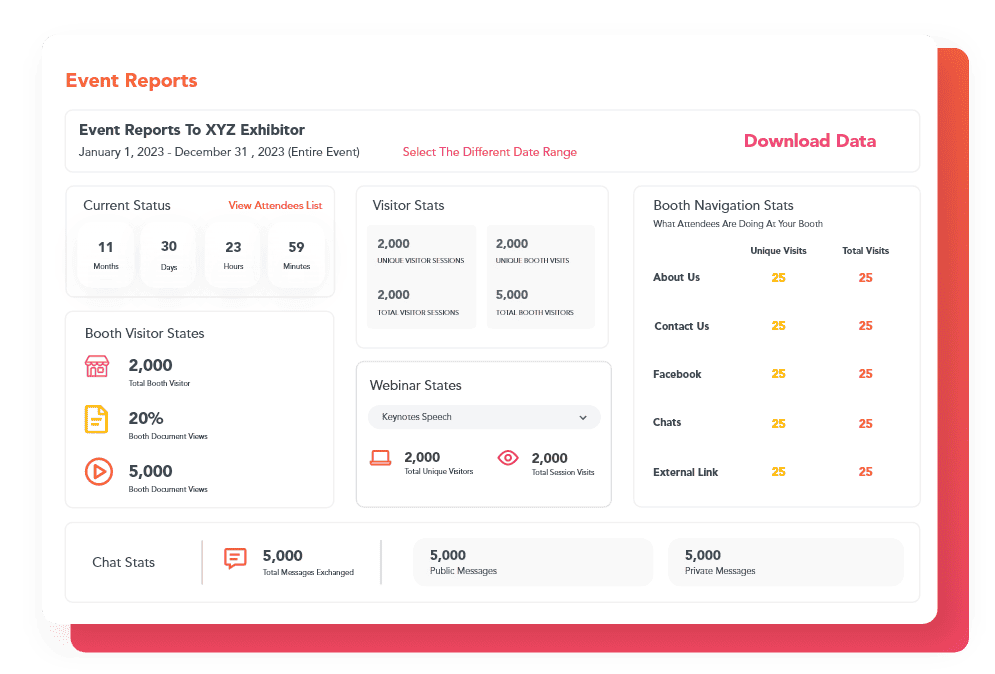
Custom Virtual Event Features
You’ll be pleased to discover that a variety of specialized features are available to provide a more comprehensive and tailored experience for your attendees. These features are particularly effective for distinctive events that extend beyond the typical virtual conferences. Some examples of these specialized features include:
1. Job Board
When hosting a virtual career fair or job fair, it’s advisable to incorporate a job board into the event. The inclusion of a job board allows exhibitors to efficiently identify suitable candidates for their open positions. This board serves as a comprehensive list of available job vacancies, simplifying the process for job seekers to discover roles that align with their skills and preferences. As a result, it streamlines the hiring process for employers.
By integrating a job board, both companies and prospective employees can connect without significant effort. All the necessary information will be readily accessible, facilitating their interaction and discussions regarding potential employment opportunities.
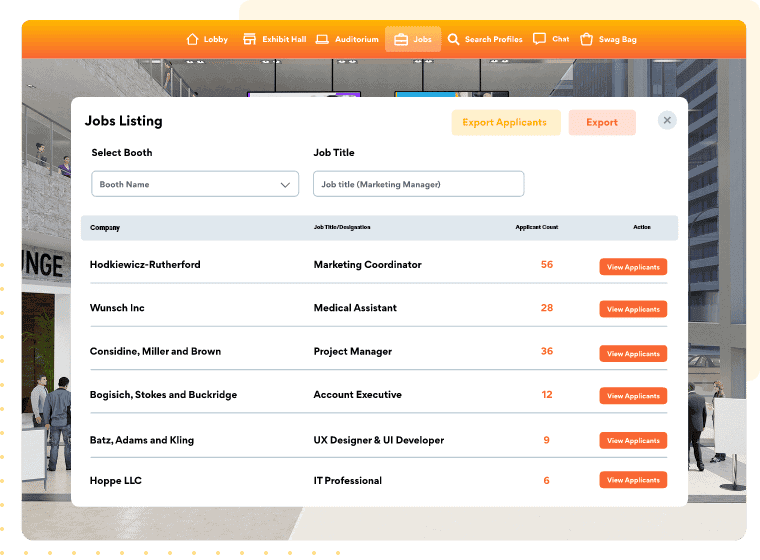
2. Poster Hall
For industries with a strong emphasis on research, it is beneficial to incorporate a poster hall into your event. This feature enables teams to showcase their posters along with accompanying presentations and engage with the audience through interactive Q&A sessions. While the presentations themselves may be pre-recorded, the presenters have the opportunity to respond to attendee questions in real time.
This poster hall serves as a valuable resource for industry professionals seeking to present data, research findings, graphics, and related content. It will be situated as a distinct section within your event, easily accessible to your audience via the dynamic lobby or the top navigation bar.
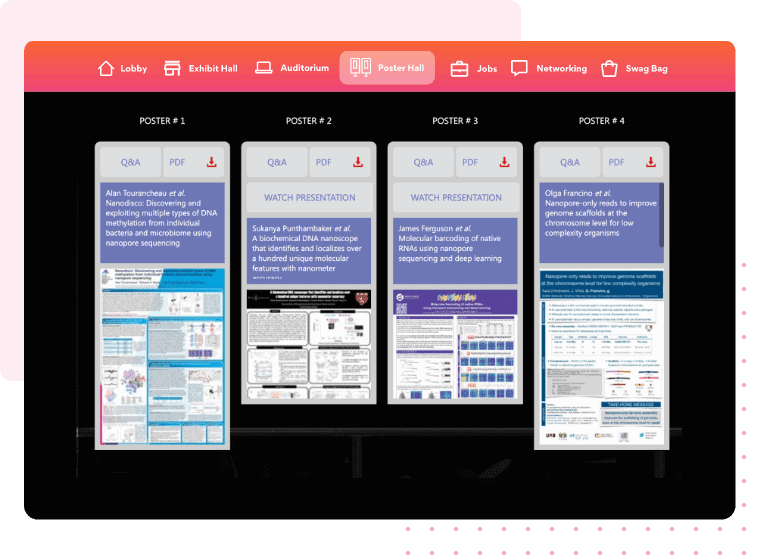
3. Shopping Cart
If you’re looking to streamline product order processing during your event, the solution is straightforward. Incorporate a user-friendly shopping cart equipped with a variety of payment methods and shipping options.
Attendees can conveniently add products to their cart, and when ready, they will be seamlessly redirected to the host’s e-commerce website to complete their purchase. This not only enhances the overall event experience but also contributes to increased revenue generated during the event.
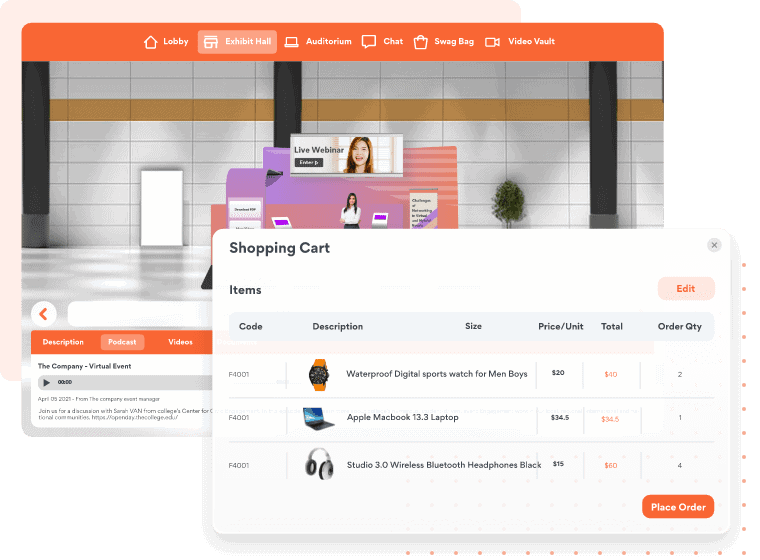
4. Exclusive Access
Are you interested in cultivating an atmosphere of exclusivity at your event? This approach is particularly effective when your event has different ticket tiers available. You can provide exclusive webinars, discussions, and private lounges to attendees in the higher-tier categories, offering them dedicated spaces for various presentations and activities.
Implementing this kind of limited access feature adds excitement to your event and motivates individuals to opt for higher-tier ticket options. If you’re looking to generate revenue from your event, this strategy presents an excellent opportunity.
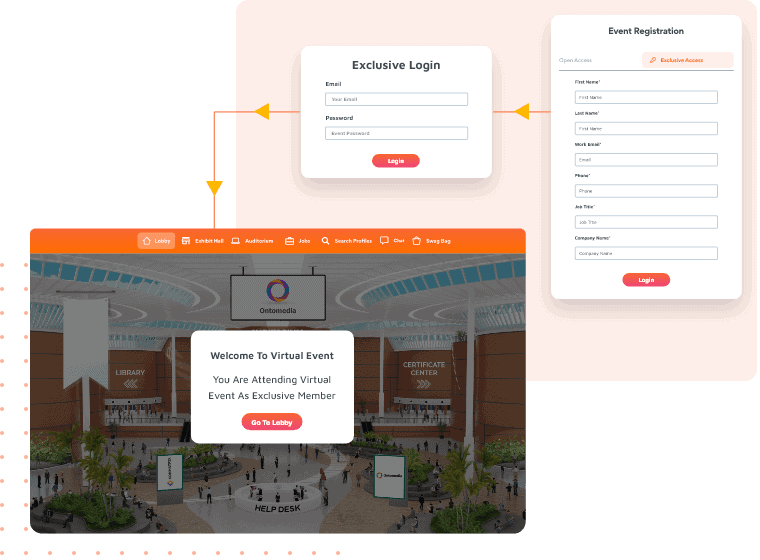
Chapter 5: Virtual Event Planning & Hosting
Executing a virtual event requires you to be extremely clear about your goals and objectives, and carefully choose what aspects to include to hit those goals. Here’s how to plan a virtual event.
1. Set Clear Goals and Objectives
Save Time and Provide Flexibility
Since virtual events require a smaller workforce, they provide speedier organization, and you may even postpone reasonably simply if required.
Improve Attendee Engagement
Increasing your participation in virtual events leads to more meaningful interactions and partnerships between your guests, sponsors, exhibitors, and stakeholders.
Integrate Multiple Platforms
It is critical to pick a virtual event management solution that includes all of the capabilities and features that your business requires to conduct an appealing, smooth event. Platforms like vFairs help you plan, promote, analyze and execute all of your virtual, hybrid, and in-person events.
Increase Visibility
Virtual events allow you to speak directly while not physically present. This enables a large number of individuals to join a conference, training session, etc. They also enhance the interaction between the company and its customers when there are geographical barriers and no physical interaction.
Reduce One’s Carbon Footprint
Virtual events require less travel and logistics, as well as fewer flyers, pamphlets, and other printed documents which can result in less carbon footprint.
Maintain Financial Balance
Virtual events allow online payments and restricted access for your members only. This means earning virtual event ROI as usual from registration fees, sponsorships, and so forth. The goals of organizing an online virtual event also include the following:
- Give people the chance to learn and meet each other.
- Gather to solve problems about a certain subject (virtual summit)
- Find leads or help sponsors or exhibitors find leads or make sales (virtual trade show or exhibition)
- Share facts or new information (virtual exhibition or conference)
- Hire new people or connect them with jobs that are open (virtual career fair & job fair)
- Announce the start of sales and the release of a product or service (virtual product launch)
2. Decide on a Theme and Format
Once you’ve decided to host a virtual conference, the next crucial step in virtual event planning involves choosing the date, format, and theme. With vFairs, you have access to a range of customizable features to craft your event to perfection. You can personalize elements such as the virtual setting, exhibit halls, event builder, and webinars that are all vital parts of your event. Additionally, you can incorporate engaging activities like scavenger hunts to captivate your audience.
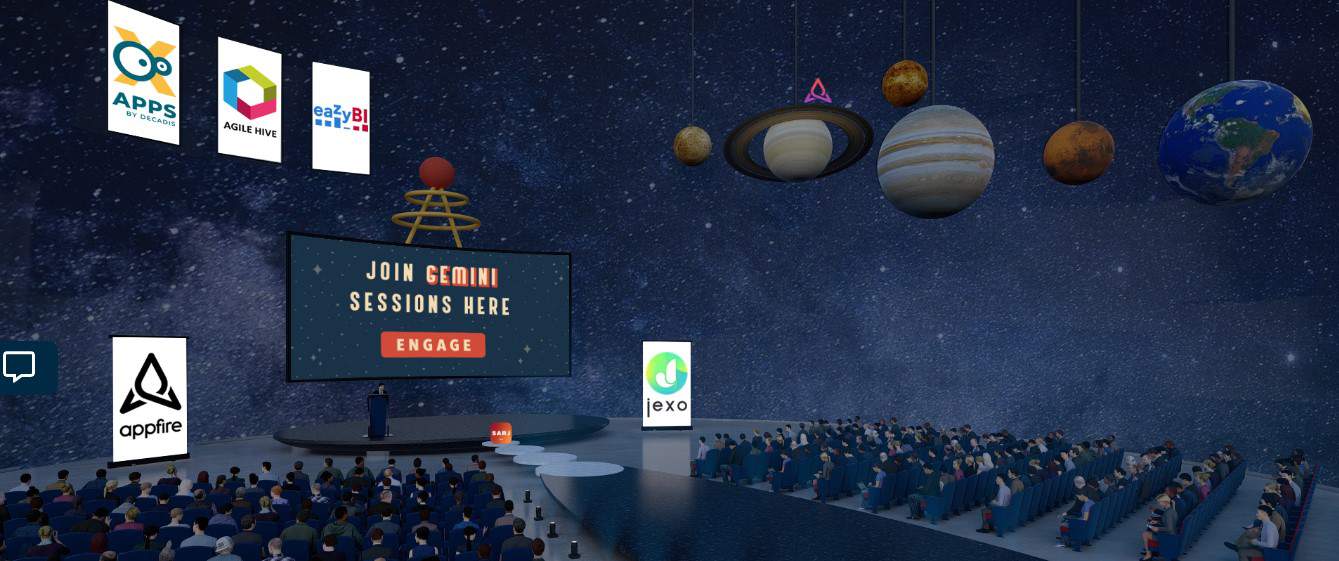
3. Prepare Your Virtual Event Attendees
User error or unawareness can be common issues while arranging a virtual event. While planning, organizers also need to consider the non-tech-savvy attendees who may find virtual events new and daunting. Most online event platforms can offer custom overlay videos. You can integrate one video on each page that acts as a guide for all attendees. It is also a good practice to post agendas and online virtual event guides on the landing page before the event starts.
4. Invite Speakers, Sponsors & Community Partner Personas
A virtual event is only as good as the content that is shared via it. Even the best software and attendance experience cannot compensate for poor material and boring speakers. While many presenters will have valuable material to provide, a professional speaker will be able to engage the audience and deliver their information in an easy-to-understand and fascinating manner. Before you start looking for the perfect speaker, you’ll need to find out a few things.
- The purpose of your event – what do you want people to take away from it?
- The date and time of your event, as well as the time you’d like the speaker to speak.
- The duration of the speaker’s presentation and the items that they can use.
- Your budget for a speaker or speakers. You can also call out for submissions where people who would like to present could apply. This means that potential speakers might have to pay you for an opportunity.
- What type of speaker are you looking for – a keynote speaker or a breakout session speaker?
- Are you planning to enlist the assistance of your speakers in advertising your event?
5. Budgeting
Creating a virtual event budget is all about identifying every cost component. Using a spreadsheet simplifies this process. It allows you to track and categorize expenses effectively, and your budget sheet should consist of three main sections:
- Overview: This section provides a snapshot of your total budget, allocated funds, remaining budget, and categorizes your expenses.
- Details: Here, you list each expense item, categorize it, specify the planned budget, and record the actual expenditure.
- Expense Tracking: This page is for your team to document how much money was spent on each item and to keep track of receipts.
Below is an example of a budget sheet that can help you manage your virtual event finances effectively:
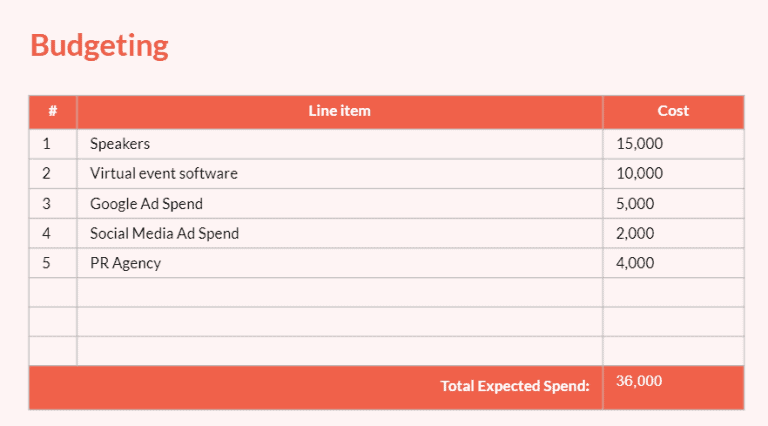
6. Choosing the Right Platform
During virtual event planning, it’s best to read honest testimonials from genuine users on sites like G2 to get ideas for which virtual event software is suitable for you. Look at other popular virtual events to see what tools and software they use.
On G2, vFairs is the most popular virtual event platform, with a 4.7/5 rating from over 1,100 clients.
7. Branding & Messaging
Now, more than ever, it’s vital to follow essential branding guidelines when crafting brand messages for virtual events. Here are a few virtual events tips regarding branding and messaging:
- Stay Authentic: Ensure your brand messaging conveys trustworthiness and expertise to come across as genuine.
- Embrace Uniqueness: Highlight what sets your brand apart from the competition. Make it clear why attendees should care about your brand.
- Create Impact: Understand your audience deeply. Craft branding messages that resonate by addressing their needs and preferences.
- Maintain Consistency: Keep your brand messaging uniform across all communication channels. Consistency fosters familiarity, authenticity, and trust in your brand.
Chapter 5: Virtual Event Engagement
Virtual events can generate nearly a third of the revenue that physical or face-to-face events can. Virtual events, despite being viewed by some as a “forced evolution” for the massive event industry, offer a clear value proposition when executed well. Although, it’s more difficult to engage your audience online than it is to meet them face-to-face. However, with vFairs, you can engage your audience in various ways. Let’s dig in!
Social Media Engagement
Social media is a powerful tool for engaging your audience. You can begin by sending a tweet, which will be displayed in the live social media feed during the event. This allows you to monitor event hashtags, collect user-generated content, and enable attendees to connect with each other. Additionally, platforms like vFairs offer features like Twitter walls and integration with wall.io, which lets you create a social wall for ongoing audience engagement during and after your virtual event.
Virtual Matchmaking
With vFairs, your participants won’t have to manually scroll through other people’s profiles for hours anymore. Based on their various abilities, passions, or fields of specialization, they can be matched. Users can complete the registration form’s numerous form fields or their user profile during the event to better match them with like-minded individuals.
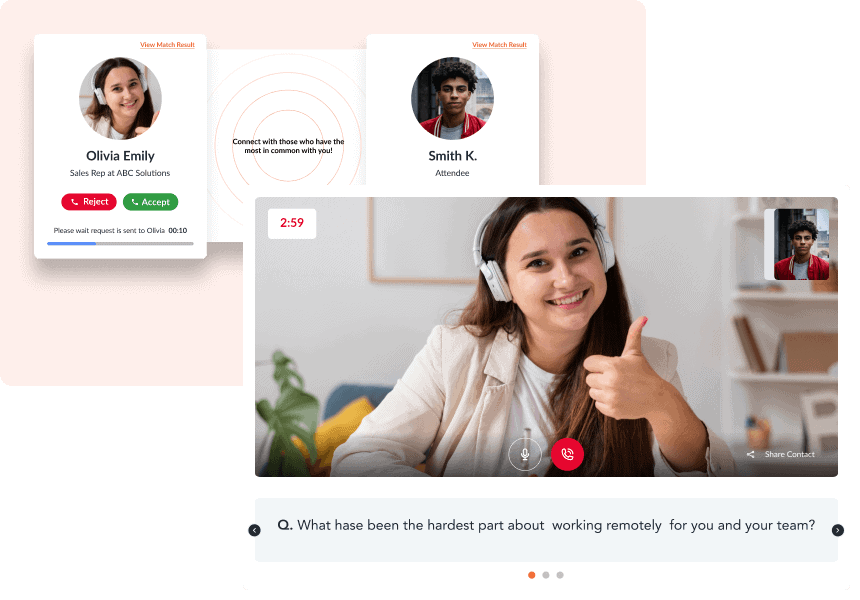
Quizzes & Trivia
You can add an exciting element of competition to your event by using in-event trivia and quizzes. You can ask your attendees questions and quiz them on topics that they’re interested in. This is a fantastic idea for industry-related subjects. It works well as an icebreaker to bring like-minded people together, and it also aids in virtual webinar engagement.
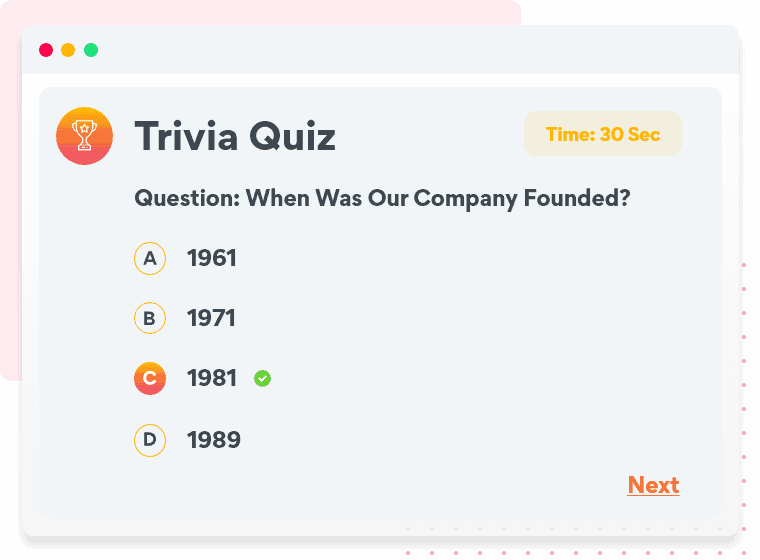
Scavenger Hunts
Adding an activity to your virtual event is a terrific way to keep your participants engaged and interested in your event. Scavenger hunts, for example, will keep your participants on their toes and your event buzzing. It is also a fantastic way to bring individuals together to network, collaborate and inspire team building.
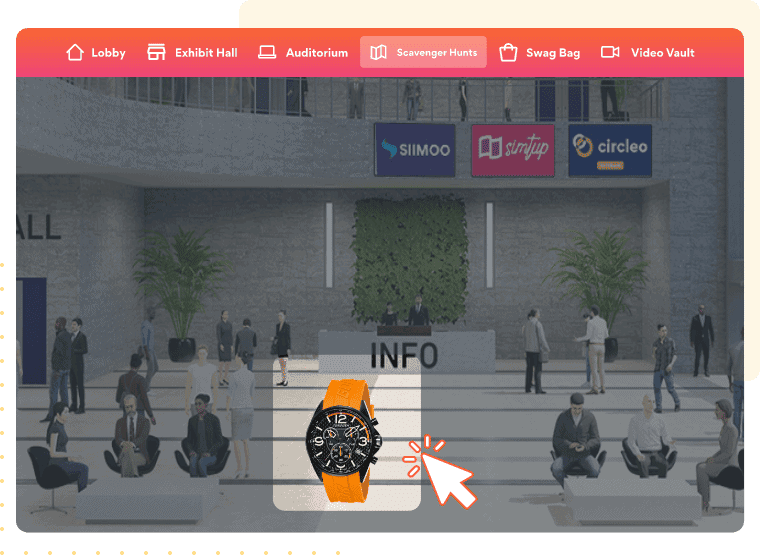
Leaderboards
A highly effective way to boost participant motivation at events is by using a leaderboard to highlight the most active and engaged attendees. This not only encourages attendee involvement but also enhances chat participation, bringing your event to life and preventing a dull and inactive chat.
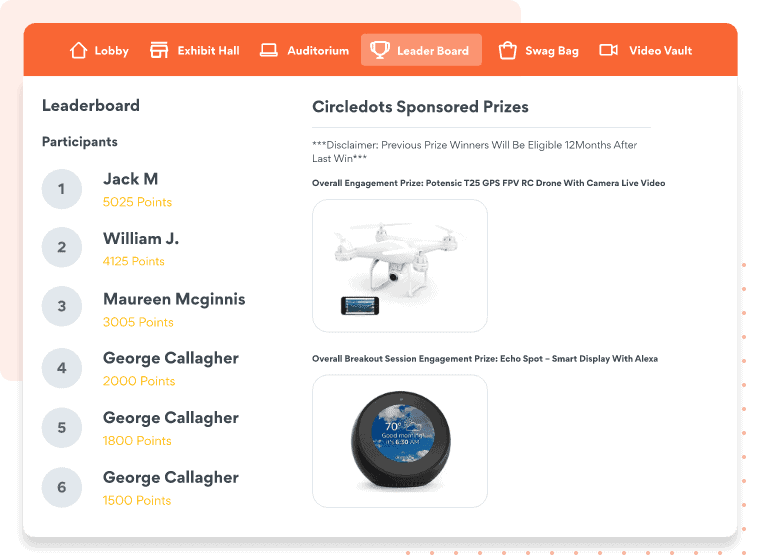
Q&As
Engaging your event audience can be achieved effectively by incorporating a Q&A session, especially during conferences or panel discussions. Traditionally, after the speakers have concluded, they would encourage the audience to ask questions in person. However, with the growing demand for virtual events and their increased accessibility, hosting live or online Q&A sessions has become a viable option.
Breakout Rooms
Breakout rooms are separate sessions from the main event. They allow the participants to gather in smaller groups and are entirely segregated in terms of audio and visual from the main session. The use of a breakout room will not only assist your participants to network with one another, but it will also aid their retention of the event’s content and information. Breakout rooms are personal and attendees are more likely to participate in discussions when groups are divided into smaller gatherings.
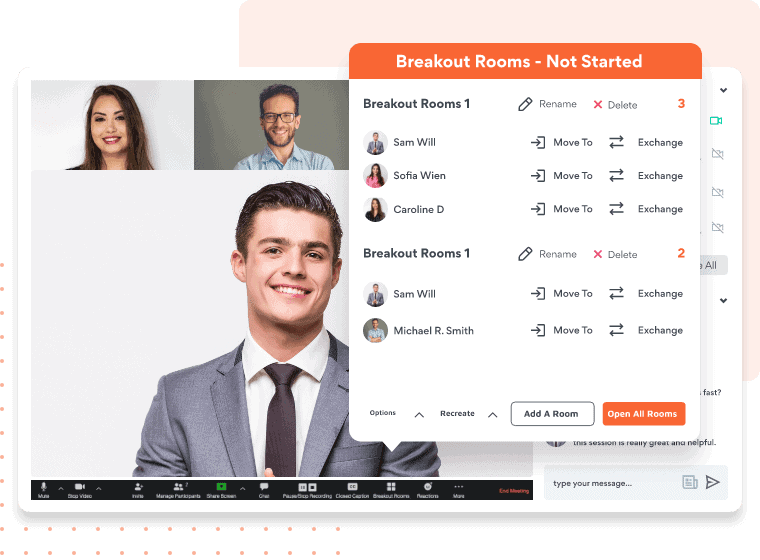
Polling and Surveys
Using live surveys and polls can greatly boost engagement during virtual events. They provide a platform for participants, speakers, and hosts to interact at their own pace, keeping them distinct yet connected. Live polls and surveys captivate participants, encouraging them to stay engaged.
In the world of virtual event marketing, especially in B2B, many professionals use polls to enhance audience engagement. These online polls are a simple way to engage with attendees during events and gather valuable feedback to strengthen your brand.
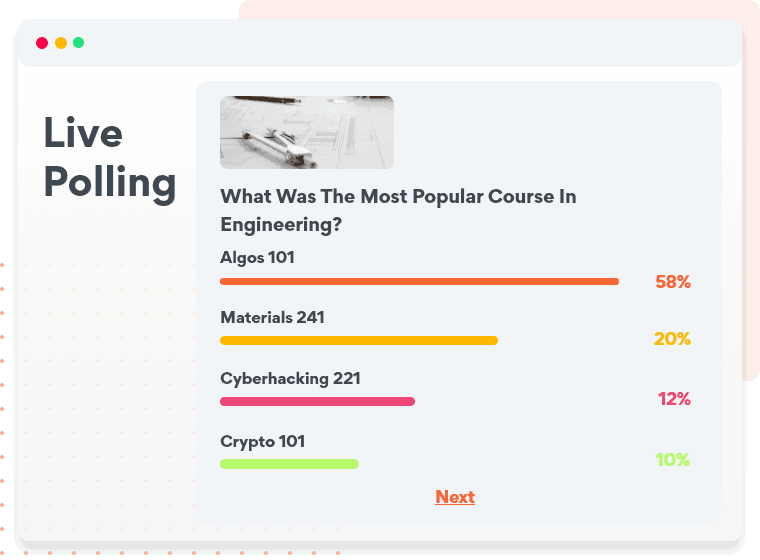
Interactive Content
Using interactive content is a great way to keep your virtual event audience engaged. You’ll find different booths and exhibitor halls where attendees can virtually connect and interact. Plus, they can easily grab resources from the swag bag and send them to their email for future reference.
Live Activity Feed
During a virtual event, you have the option to livestream on various social media platforms, allowing attendees to engage with one another. This is a fantastic method for audience engagement, as it enables interaction across different platforms.
Virtual Photo Booth
Another excellent way to entice your guests is to set up a virtual photo booth. You can create branded photo templates and offer filters to better engage your audience. Your audience will be able to save and share photos in the virtual photo booth, creating a unique keepsake from your event.
Contests
A fantastic virtual event engagement idea is to organize a contest. To run a successful contest, consider the details and decide on a prize or reward. It can be as straightforward as encouraging attendees to share photos or images of their virtual event experience as user-generated content. You can also engage them with questions, fun polls, or other interactive activities related to these options.
Chapter 7: Virtual Event Marketing
Promoting your virtual event requires the same effort, if not more, as a real-life physical event. However, the specific event marketing strategies may differ. You ideally want to make sure that your online and video programming speaks to the right audience and doesn’t get lost in the crowd. Here are some fantastic virtual event tips to make sure you reach your attendee engagement goals.
Promote on Your Site
Using your website to promote your next virtual event is a great approach to getting people interested. We recommend including a prominent area on your website’s homepage that directs visitors to your virtual event’s landing page.
Interstitials, banner ad placements, and message panels that attach to the bottom or top of the page are some of the more advanced options. However, more crucially, the copy you put in your advertisement has a significant effect. Make a compelling headline that conveys what’s in it for participants and creates an urgency to drive them to act right away.
Interact on Social Media
It is critical to promote yourself on social media. Use both organic and paid promotion, as well as remarketing. The most obvious approach to using LinkedIn and Facebook to your benefit is to constantly publish updates to your follower base about your upcoming virtual event.
Remarketing on LinkedIn, Facebook, and Instagram uses web technologies to track those who visited your event’s page but did not register. They work to display advertising to these same individuals using insight tags on your virtual event website or the landing page.
Opt for Paid Media
If you’re in a hurry to increase the number of people who register for your virtual event, paying for extra traffic is a crucial move to attract your target audiences online. Creating tailored marketing that targets the correct audience, geographic locations, and demographics can assist in raising event publicity and exposure.
Leverage Email Marketing
You can use effective email marketing strategies to raise registrations for an event, keep participants informed before the event, and engage attendees leading up to your virtual event. At all stages of the event, email is the greatest way to contact guests. Use an email marketing technology that can send branded, tailored emails, track open rates and click-through analytics, and automate when and to whom emails are sent based on attendee data. When it comes to sending out pre-event emails, be as generous as possible. Don’t just send one reminder and assume it’ll suffice as emails are easy to overlook. Before your event, it’s a good idea to send at least four reminder emails:
- A week before the event
- One day before the event
- On the day of the event
- At the commencement of the event
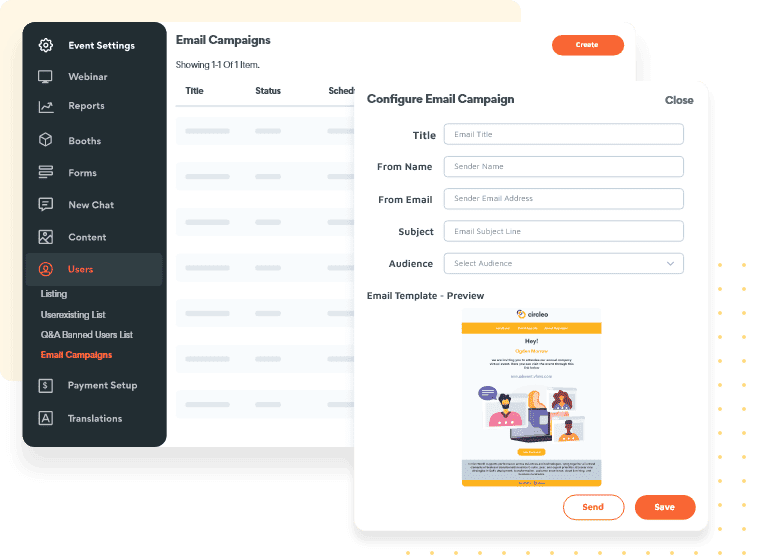
Utilize Content Marketing
Content plays a crucial role in the success of any event. Content marketing involves creating and sharing valuable, relevant content to attract and engage your target audience. Whether you’re promoting a virtual conference, a product launch, or a live seminar, a well-executed content marketing strategy can build anticipation, drive registrations, and enhance the overall attendee experience.
From blog posts and social media updates to videos, webinars, and email campaigns, content marketing allows event organizers to tell a compelling story, provide valuable information, and establish a strong connection with their audience, ultimately ensuring the event’s message reaches and resonates with the right people.
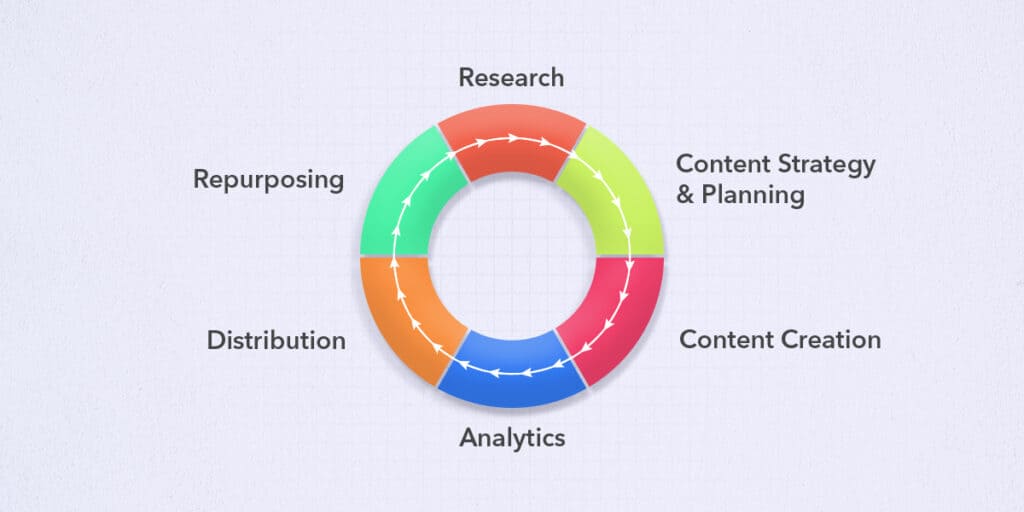
Spread the Word through Speakers and Sponsors
Collaborate with sponsors to enhance your virtual event marketing efforts. Encourage them to promote the virtual event on their websites, social media, and other digital platforms. With their permission, you can even send emails to their subscriber lists or create guest posts on their websites.
Incorporating your unique guest speakers into your event strategy is also beneficial. These ambassadors and spokespersons are often the primary attractions of virtual events, drawing in audiences eager to listen, engage, and learn from them. Involve them in discussions and conversations related to your virtual event to naturally generate interest and excitement.
Chapter 8: Advanced Virtual Event Strategies
With the growing competition in the virtual event field, you’ll need a standout virtual event marketing plan to enhance conversions, generate interest, and increase attendance for your next virtual event.
Strategy 1: Promote Your Event
Unlike traditional events, which need 6 to 12 months of planning, you can complete virtual events in 1 to 3 months. Setting up a virtual event gives you more time to focus on promoting your event because you don’t have to secure a physical venue ahead of time. Here’s how to promote your event in general:
Before the event:
- Figure out who your target audience is.
- Create landing pages.
- Send out direct mail campaigns.
- Create contests and social media posts.
- Make a website for the event.
- Launch your email marketing campaigns.
- Send email reminders.
During the event:
- Continue to send out reminder emails.
- Make real-time social media updates (Facebook, Twitter, LinkedIn).
- Share downloadable stuff.
- Use live chat or chatbots to answer queries.
- Organize branded activities and experiences.
Strategy 2: Give Teasers
Don’t give away all of your secrets right away. Give your viewers cliffhangers to keep them guessing. Keep your audience wondering and wanting to return to your website or event page for more information.
Strategy 3: Create a Custom Virtual Venue
Many virtual conferences and events have recreated their familiar physical venues. Moreover, individuals can create their own virtual festivals, complete with various themed areas to explore. An excellent example is NOLO Land, a global interactive virtual event hosted on vFairs, centered around non-alcoholic and low-alcoholic drinks, organized by IFF for its customers. What set it apart was the presence of multiple virtual venues within a single event, each offering a unique look and atmosphere. Transitioning between these venues also brought changes in background music and avatar interactions, making it a dynamic and immersive experience.
Strategy 4: Keep Up With Tech Trends
In today’s rapidly evolving landscape, it’s essential to keep a vigilant eye on the ever-changing tech trends that continue to shape the industry. These trends not only offer innovative ways to engage and connect with audiences but also hold the potential to transform the entire event experience.
Facial Recognition
Face recognition technology has gained immense popularity. It operates by scanning a person’s face and capturing their photo during event registration or check-in. People commonly employ facial recognition on their mobile devices and in workplaces. This technology greatly simplifies mundane tasks such as unlocking your phone, accessing apps, or enrolling for an event.
Gamification
The use of games at events is a huge trend. Gamified events get a lot more people involved, which makes them a great way to improve the experience of those who attend. If you want more people to download your mobile event app, tell them about the games they can play within it. You’ll see the number of downloads go through the roof.
NFTs
NFT stands for ‘Non-Fungible Token’. In general, this can mean drawings, songs, or other original works. You can use NFTs best at virtual events, but most event organizers are still getting used to the idea. Since NFTs may help you break through the noise and establish yourself as a market leader as well as generate revenue from your virtual event, this is a win-win. For instance, you can use NFTs to sell digital versions of branded goods. This can be done with digital posters, event souvenirs, or even clips from the event itself. You can also sell custom avatars, mint artwork, and even event items themselves.
Strategy 5: Gather Sponsorships for Virtual Events
Many event organizers can ignore the importance of sponsored media during virtual events. Not only does that make your event look more legit, but it can also help you arrange a portion of what the entire event costs. Event platforms like vFairs can help you give the right promotional space to all your sponsors.
When reaching out to potential sponsors, you can present enticing virtual event sponsorship packages similar to those offered at physical events. Platinum, gold, and silver sponsors can secure distinct spaces within the virtual exhibit hall and lobby, gaining prominent mentions in promotional newsletters and on the event’s landing page. These virtual event sponsorship opportunities ensure that sponsors receive the visibility and recognition they seek. Here is a great sponsorship slide deck that you can use.
Strategy 6: Content Partnerships for Promotion
Content partnerships with social media influencers, relevant experts, and your keynote speakers can help promote your event to the right audience. They can post a promotional video inviting their followers to attend the event as they will be there too. Most attendees interested in what your keynote speaker has to say probably also follow them online. This way, you are reaching the right audience by getting the word out. Relevant experts and exhibitors at your event can also promote your virtual event from their official company channels.
Strategy 7: Post-Event Polls and Surveys
Sticking around even after the event is over can be an effective way to provide relevant information, engage with attendees, and answer their questions. It can also help you receive immediate feedback and build a network. Event organizers can also ask for feedback after the virtual event has come to an end by running polls or online surveys. Following up with attendees by asking the right questions can help organizers gather insight and learn. It is a great strategy to figure out the areas of improvement and expand on successful verticals.
Key Takeaway
While we acknowledge that virtual events may not match the impact of in-person gatherings, there are situations where going virtual becomes a necessity, often on short notice. With proper planning and the use of the right virtual event platform, this transition can be a secure way to deliver engaging and informative experiences to your attendees, mirroring the efforts you put into your in-person events.
FAQs
How to host a virtual event?
Below are a few examples of what you can do while hosting a virtual event:
• Share and learn about industry insights.
• Connect with experts and peers virtually.
• Discuss issues and ideas that are relevant to both of you.
• Look for talent throughout the world.
• Attract new companies.
• Showcase and sell your products/services.
• Recruit new students for colleges and universities.
• Celebrate graduations and other significant anniversaries.
• Make connections between students and real estate agents.
• Incorporate new hires into your organization by training and integrating them.
How do you make a virtual event fun?
People use interactive virtual events to network, engage with like-minded people, and find new potential clients. Interactivity is an interesting and enjoyable approach to personalize an event. Here are some fun elements to include during your virtual event planning.
• Make your quizzes and surveys.
• Encourage people to vote in virtual events.
• Create an enjoyable learning environment.
• Create memories with an engaging virtual event platform like vFairs.
• Allow attendees and organizers to communicate in real-time.
How do you name a virtual event?
Your event's name is the first impression it makes, conveying its tone and what attendees can expect. In a crowded landscape, a memorable and clear name is essential. When naming your virtual event, remember to make it self-explanatory and leave a lasting impression. Consider creative strategies like wordplay, drawing inspiration from local history, combining words, or using industry or cultural vocabulary to craft a distinctive and engaging name that sets your event apart from the competition.
What is virtual meeting?
A virtual meeting is a type of gathering or interaction that takes place online rather than in a physical location. It involves people coming together through the internet using various communication tools and platforms such as video conferencing software, webinars, or collaboration apps.
What are the benefits of virtual events available on demand?
On-demand streaming may be the correct solution for you if your audience can't attend your live event or if you want the significance of your live broadcast to last so that future audiences may access and participate in it. On-demand events enable you to expand your reach and reach the largest possible audience.
You may have all the benefits of an interactive livestream with the added benefit of being able to edit out the parts you don't like. You can also tighten up segments, and even add additional content including audience interactions, music, and more interviews to boost the value of your event.
What are virtual event sponsorships and how do they work?
Virtual event sponsorships refer to partnerships between event organizers and external companies or organizations that provide financial support, services, or resources in exchange for promotional opportunities and visibility within a virtual event. These sponsorships can help offset event costs and enhance the attendee experience. Typically, sponsors receive various benefits depending on their sponsorship level, such as logo placement, speaking opportunities, and dedicated virtual spaces within the event platform.
What is the difference between a virtual event and a hybrid event?
There are no physical attendees at virtual events because everyone participates electronically through a virtual event platform. However, hybrid events combine the advantages of both types of events. Some of the participants can attend in person, while others will be “brought in virtually,” enhancing the overall interaction.
What is the difference between a virtual event and an in-person event?
In-person events necessitate that all attendees be present in a physical location at the event’s start time. In-person gatherings are a great way to meet new people, catch up with old friends, colleagues, and industry peers, and expand your career or personal possibilities.
Virtual events, on the other hand, are those that everyone attends over the internet. Venues and food are no longer necessary because event organizers can e-meet people online. This reduces manual labor and lowers technical costs. Hosting events online is also more cost-effective because there are no time or space constraints.


